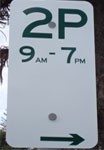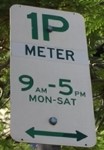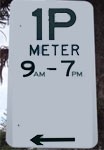Parking signage
View the different parking signage on the Sunshine Coast.
Traffic signage on the Sunshine Coast conforms with the Manual of Uniform Traffic Control Devices (Queensland), within the meaning of the Transport Operations (Road Use Management) Act 1995. The manual contains the design and methods, standards and procedures relating to every sign installed on Sunshine Coast roads. This includes:
- signs
- signals
- markings
- lights
- devices.
Contact council for missing, faded or illegible signage.
General signage not including time restrictions
No Stopping and No Parking signs and lines help traffic flow, ease congestion and enhance safety for motorists, pedestrians and cyclists. Always check the signs and lines before parking your vehicle or before reporting illegally parked vehicles.
There are many different parking restriction signs, which may seem confusing at first. The following information will help you understand the different general signs:
| Sign type | Example | Important information |
| No stopping |  | A driver must not stop on a length of road or in an area to which a no stopping sign applies. There may also be a yellow edge line which also means that stopping is not allowed. These lines can be used either on their own or together with a no stopping sign. |
| Clearway |  | A driver must not stop on a length of road to which a clearway sign applies. The only exception is if the driver is driving a bus or taxi and is dropping off/picking up passengers. |
| No parking |  | Vehicles may stop for up to two minutes if the driver is dropping off/picking up passengers or goods. The driver must remain within 3m of the vehicle. |
| Loading zone |  | Unless otherwise signed, vehicles may stop in a loading zone for up to two minutes of dropping off/picking up passengers or up to 20 minutes which dropping off/picking up goods. Unless otherwise indicated by the sign, buses or trucks dropping off/picking up passengers/goods and vehicles displaying a commercial vehicle sticker issued by council are permitted to stop in a loading zone for up to 30 minutes. Loading zone: Any vehicle may park for a maximum stay as displayed on the sign. |
| School loading zone (2 minutes maximum) |  | All vehicles may only park for a maximum of two minutes during the times stated if on a school day. |
| Bus zone |  | A driver must not stop in a bus zone, unless the driver is driving a bus that seats over 12 adults. Parking is not permitted 20 metres before or after a sign indicating a bus stop. |
| Taxi zone |  | A driver must not stop in a taxi zone, unless the driver is driving a licensed taxi. |
| Mail zone |  | A driver must not stop in mail zone. |
| Disability parking space |  | A driver must not stop in a parking area for people with disabilities unless the driver's vehicle displays a current Australian Disability Parking Permit. All permits must be displayed at the left side or centre of your front windscreen with your permit number and expiry day visible from the outside. |
Time restricted parking signs
These parking zones require payment if the word 'METER' is displayed (currently Caloundra and Birtinya).
Time limits and payment only apply within the hours and days indicated on each sign.
The P stands for parking, and the large number tells you how long you can park there. The times below tell you when the sign applies. Your time starts when you park the car, not when you leave it.
Once you've reached one hour, you cannot just buy another ticket or feed the meter. You must move your car off the length of road or out of the area that the sign applies to.
The following information will help you to understand the different time restriction signs:
| Sign type | Example | Important information |
| Timed parking where days are stated* |  | During the hours and days displayed, vehicles can stay up to the maximum time stated on the parking sign at no charge. Time restrictions do not apply on public holidays, unless specifically mentioned. Vehicles can park for unlimited time outside of the hours stated on the sign. |
| Timed parking with no days stated* |  | During the hours displayed, vehicles can stay up to the maximum time stating on the parking sign at no charge. Time restrictions apply on all public holidays. Vehicles can park for unlimited time outside of the hours stated on the sign. |
| Paid parking where days are stated* |  | During the hours and days displayed, parking must be paid for at a parking meter. The maximum stay permitted is indicated on the sign. Time restrictions and payment requirements do not apply on public holidays, unless specifically mentioned. Vehicles can park for unlimited time outside of the hours stated on the sign. |
| Paid parking with no days stated* |  | During the hours displayed, parking must be paid for at a parking meter. The maximum stay permitted is indicated on the sign. Time restrictions and payment requirements apply on all public holidays. Vehicles can park for an unlimited time, and without making payment, outside of the hours stated on the sign. |
